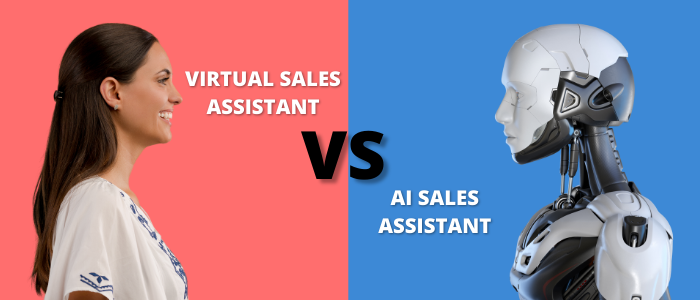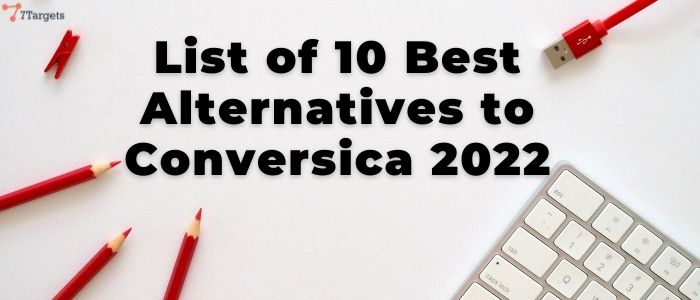Comparison between Virtual Sales Assistant and AI Sales Assistant


Video on Comparison between Virtual Sales Assistant and AI Sales Assistant
Will Virtual Sales Assistants become a thing of the past as AI Sales Assistants continue to become better? Or is your virtual sales assistant actually using an AI Sales Assistant in the background as well?
Let’s compare what you get when you are working with virtual sales assistants Vs AI Sales Assistants. Before we start, let’s just define these terms, so we all are on the same page.
Virtual Sales Assistants are outsourced, mostly remote, salespeople that help you to create a lead pipeline for you. They can be in different countries and in different time zones.
AI Sales Assistants are software programs that behaves like human sales people. You can create an AI sales assistant with your name so that it looks like an impersonation of yourself. You can also create an AI sales assistant as if it’s a new person with a clear job title, role, and responsibility.
Well, let’s compare the pros and cons of when to use which and what value do they add. Let’s look at sales simplistically as
-
Reach out to target personas that fall in your sweet spot
-
Connect and Nurture the leads
-
Setup a meeting once the lead is interested
-
Negotiate and Close the deal with interested parties
The goal is to get a repeatable performance thereby creating a working sales playbook to get each of the above steps nailed down to the T.
Let’s look at each of these phases and see which Sales assistant works better where.
Reach out to target personas that fall in your sweet spot
Generally, you’ll find targeted personas on Facebook or LinkedIn where you can enter a clear definition like “VPs of Technology Companies”, or “Heads of call centers” etc.
You can quickly find out How to use LinkedIn Navigator for B2B Lead Generation here.
Now, either you can have humans do these activities of creating a list, going to each one of them, and then send the correct message or you can have an AI sales assistant do the same. The difference is that an AI sales assistant is 100% repeatable. It sends messages at an extremely efficient pace, it takes no holidays because it’s a program! A human may take a holiday and he may not be 100% accurate at all the time. But of course, the human is more intelligent.
For example, someone is running a pizza-related call center, a human may personalize a message better, and that makes a huge difference. So, if you are in a current situation where you don’t know which message works, then humans work better here. They test with different messages and check what works best.
The goal is to establish repeatability in every phase which includes how to connect, what’s the most effective message that gets an initial response. If this part is not repeatable yet, you may have to find out a repeatable pattern either via a human or by creating 4 or 5 AI sales assistants putting AB analysis in place. AI Assistants provide correct numbers of various tests to help in decision making. For example, if a particular message was sent to 400 prospects and you got a 2% response rate with one message and 3.5-4% response rate with another, the assistants help you to understand this at a much granular level than humans running the same test. Practically, we have seen humans do not run AB analysis tests correctly. Sometimes a person is on leave, sometimes the email is sent too early by mistake, and sometimes the data collection during a test run is not good enough. If this process is managed in an extremely process-oriented way, then achieving repeatability in 4 to 5 iterations is generally possible. But it can take 3 to 4 months too. It mostly depends on how niche your target audience is. If you can boil down the query to filter less than 2000 people or so, generally you will have a very sharp message, an excellent corresponding landing page, that will have a higher chance of conversation.
Connect and Nurture the leads
If you outreaching via LinkedIn or Facebook or Email or other mechanisms - we are essentially asking for permission to connect. LinkedIn allows 300 characters (no images, no links) to introduce yourself and ask for a connection. Once the lead accepts a connection, you can send bigger messages with files, images, and links.
On emails, rules in certain countries ask you to email only those who have agreed to accept emails from you. You may not be allowed to send more than 1 or 2 connection-request emails per week, based on the laws of different countries. We recommend keeping it like LinkedIn - simple, short, direct character-based email that asks for connection request. If the lead does NOT reject a connection, either he/she has not seen the request, so we recommend sending not more than 3 emails in the following weeks to check if the lead is interested. You can decide based on the country you are targetting and the rules there to make a final decision on the initial introduction email and how many you should send. In EU, even 2 emails maybe good.
Each email needs to have nurturing content so that the lead can make an informed decision whether he wants to accept a connection or not. Very similar to how someone on LinkedIn opens your profile and sees more information about you.
It is crucial to send a ‘relevant’ set of messages with correct success stories to each persona based on the title of the person. For example, if it’s a Manufacturing Vice President of Ford, (or Tata Motors), then manufacturing-related stories are to be sent. Similarly, for the Pharma sector, Pharma-related success stories need to be relayed. It sounds pretty obvious that sending relevant success stories to the relevant audience is critical for getting a double response rate, but you will be surprised to see how generic email templates are written by most marketing teams and how many email templates do not include any success story link at all.
Writing generic emails to satisfy ‘most leads’ is the #1 mistake in email marketing.
Since AI assistants are programs, they do not miss attaching relevant success stories. They are 100% accurate. Humans are more intelligent; where they may put another cover letters along with the email, which can also improve the responses. But the human process may not be scalable.
If you are a SAAS company and you want to grow globally, you may be better off with a scalable process which is using AI-based sales assistants. If you are looking to run a small pilot and trying to figure out your market traction, a virtual sales assistant who uses an AI Sales Assistant may be the fastest way to determine product-market fit.
Choose wisely, or choose based on data. Create and tweak the Assistant in a controlled way because every Dropped Lead = Lost Revenue.
See how Every lead is nurtured using 7Targets AI Sales Assistant.
Setup a meeting once the lead is interested
After you have targeted leads who qualify your buyer’s persona and nurtured them at proper intervals along with relevant success stories according to their industry, there are high chances that you’ll get positive responses from them. They might want to connect with you on call or setup a meeting to understand your service further. A virtual sales assistant, who is a human can understand what the lead is trying to say and can give a satisfactory reply. On the other hand, an AI sales assistant, which is a program that might not be able to understand and respond accordingly as of today. That complex technology of coordinating meeting timings among various stakeholders is still evolving. Influencing a lead with your Unique Selling Proposition can be better done by a Virtual sales assistant rather than a human. AI assistants cannot excel in this skill yet.
A word of caution- we have seen multiple instances where a human assistant is not comfortable in getting on a call at a moment’s notice. Many times a lead may say, ‘Let’s connect’. Or ‘Send me more information. Such conversations need to be responded to ASAP. Delaying to respond even by 1 hour can mean not getting another response from the lead for another week. This can prove painful.
Keep your responses ready for frequent types of conversations and have the human assistant jump on it, or an AI Assistant get trained for it with self-learning models.
Close the deal
The final stage is to negotiate and close the deal. Negotiating and closing the deal requires a critical understanding of the value of your service, the status of your business, what is the profit margin you are looking for, the potential of the customer, and many such complex aspects. And coming to terms with the final deal by optimizing all the aspects needs a human brain than an AI program. This can be better pulled off by a Human Virtual sales assistant or BizDev, rather than an AI Sales Assistant.
Final Takeaway
The first two steps of opening a huge funnel across a large geographical area, of course, I would say that an AI sales assistant does a better job and the last two phases are better done by a human. This gives you the best of both worlds.
Other key points to be considered:
Training
If a good salesperson is working and is excellent at getting new connections, you already may have a sequence ready. But you cannot expect everyone to perform at that ‘excellence level’. So, if you get an AI assistant and program it using this human learned sequence, you’ll get to 100% repeatability soon. That’s the best part of making it accurate so you know you don’t have to train anybody else again. The AI Assistant will repetitively send messages with 100% repeatability and that too at logical intervals. AI Assistant will understand basic replies like Out of Office and will reschedule the next follow-up. You will just have to program it once and it can give 100% replication at speed and at scale without your intervention.
Cost of customer acquisition
Once you use an AI sales assistant, the cost is pretty much locked down because it is a program, you know exactly how much it is going to cost. There is no expectation of increments or promotions. When it comes to actual everyday workings, make sure your customer acquisition cost is clear to you and doesn’t fluctuate. Virtual sales assistants may have a different cost of customer acquisition for different geography. But in the case of AI sales assistants, the cost across the world is the same as most are cloud-based programs.
Updating CRMs
Updating CRMs is also very important in sales. You need to have visibility as management as to what exactly is happening with each lead. Here AI sales assistant updates CRMS like salesforce, Hubspot, etc for each email sent with accuracy.
You can have a clear idea about how an AI Assistant engages leads and updates Salesforce automatically here.
Generally, humans do not have that kind of discipline and you might find it tough to make people enter quality data in CRMs.
To summarize, at least for the first two phases of the sales where you are reaching out, nurturing the leads, you can have your CRMs updated properly. Once the leads show interest because of proper and timely nurturing, the salesperson is also motivated because he gets an already interested lead who might become a potential customer. In turn, he gets his commission too. So he will be delighted in keeping things updated for warm leads in CRM.
Human Sales generally fail to update CRM for cold leads. Here, AI Sales Assistant work better.
To sum up, if you are at the initial stage of figuring out what works, which message works, then a virtual sales assistant will be a better choice. But if you are looking for 100% repeatable and scalable results then an AI sales assistant is the best choice for you atleast for the first two phases of sales. Also, one more important aspect to be considered is which one is more suitable regarding the cost of customer acquisition.
You can visit our website and Feel free to sign-up for a free trial and give it a try and get started on how an AI sales assistant can help you achieve 100% repeatable and scalable results.










Comments